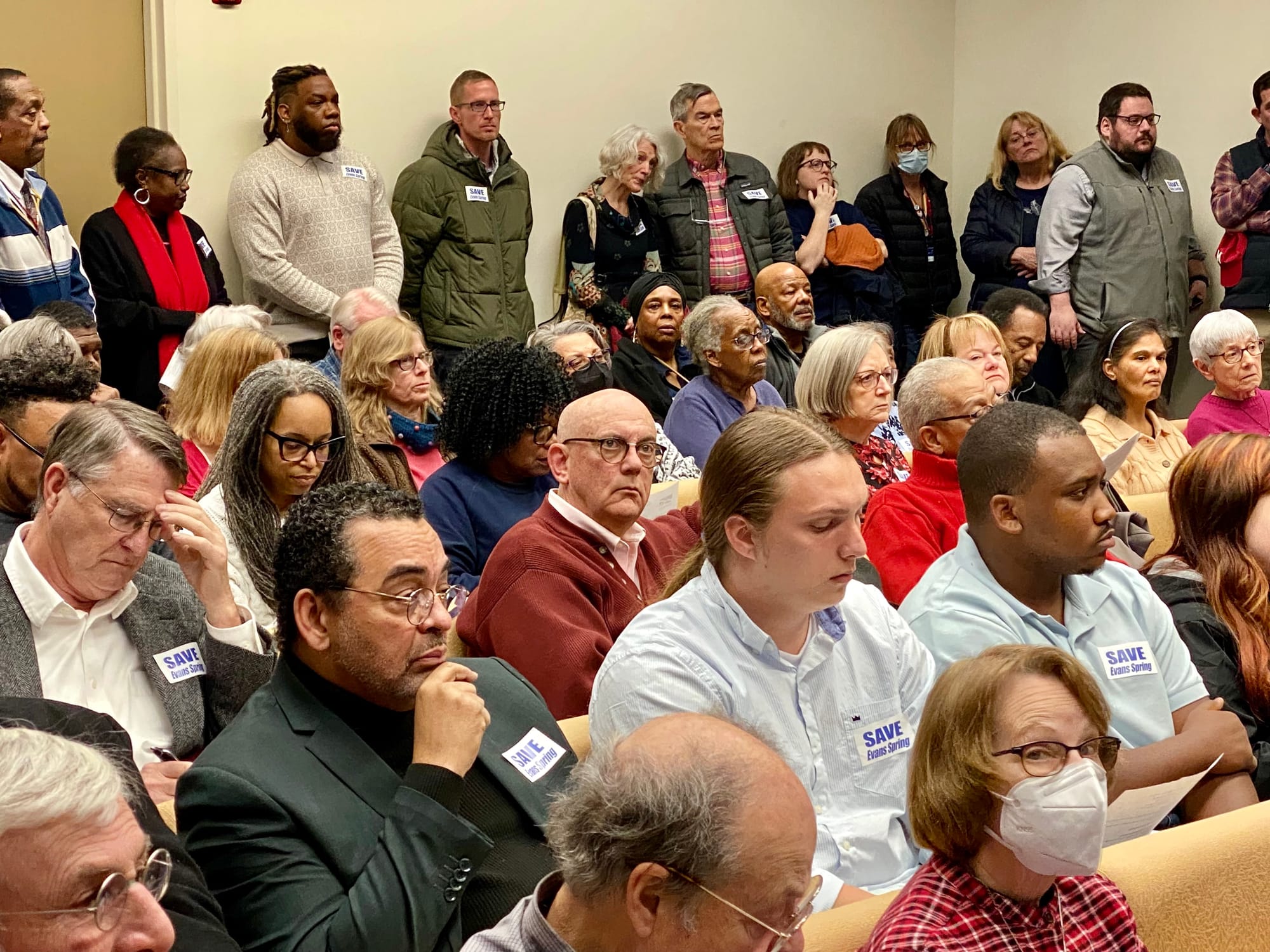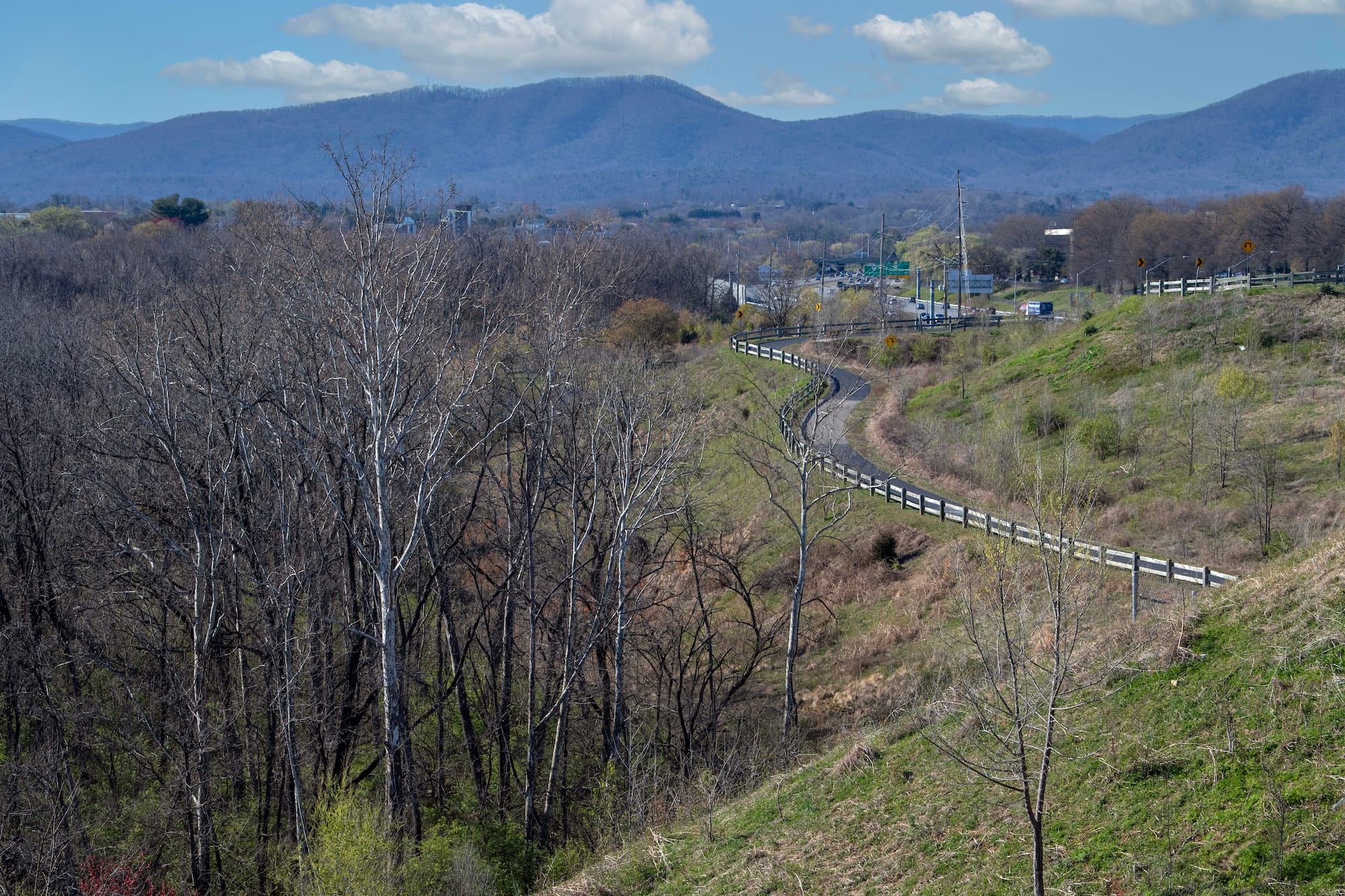Despite Public Outcry, Roanoke Council Adopts Evans Spring Plan To Guide Development
The plan says Evans Spring should become a mix of big box stores, smaller shops, and hundreds of houses and apartments.

Roanoke leaders on Tuesday narrowly adopted a plan for Evans Spring meant to encourage large-scale development at the 150 acres of privately owned woodlands across from Valley View Mall.
After nearly three hours of hearing residents opposed to the idea, City Council voted 4 to 3 to fold the development plan — which the city had commissioned from consultants — into Roanoke’s guiding land-use document.
The plan says Evans Spring should become a mix of big box stores, smaller shops, and hundreds of houses and apartments.
Mayor Sherman Lea and Council members Vivian Sanchez-Jones, Peter Volosin and Trish White-Boyd voted to adopt the plan. Vice Mayor Joe Cobb and Council members Luke Priddy and Stephanie Moon Reynolds voted against the plan.
“I think this would be a good thing, if we’re fortunate enough to get somebody to come in,” White-Boyd said. “Our neighbors are growing at a rate twice as fast because they are taking advantage of commercial opportunities and development.”
No developer has submitted plans for acquiring and developing the land. The master plan is meant to guide any future development.
Controversy over the land has stewed for decades. Neighboring residents opposed to major development invoke concerns related to traffic, the environment and racial justice. Evans Spring borders three predominantly Black neighborhoods, and some see the city’s push for development as a modern-day version of urban renewal.
“Throughout the course of history in the United States, colored people, Negros, Black people, African American people, have been displaced,” said Brenda Hale, president of the Roanoke branch of the NAACP. “We have an opportunity here to change that paradigm.”
Proponents of development say Roanoke needs more housing to allay an affordability crisis and new amenities to boost the local economy. Consultants say a major development could create more than 2,000 construction jobs and more than 1,300 service industry jobs.
The master plan says the city could expect to reap nearly $3 million in average annual tax revenue over the next 20 years if the development is fully built out.
More than 100 people packed the City Council chambers Tuesday night. Two dozen residents voiced opposition to the plan.
“If you drive through the neighborhoods of Round Hill and Washington Park and Melrose Rugby and Villa Heights and Fairland, you'll see perhaps 100 signs encouraging you to ‘Save Evans Spring,’” said Cam Terry, a farmer who operates the nearby Lick Run Farm. “I challenge you to find a single sign that implores you to cut down thousands of trees in order to build the next abandoned Sears.”
Only two speakers — both members of the city’s Economic Development Authority, which helped finance the plan — expressed support.
“It is a sound plan,” Tamea Franco said. “This would be a key economic development project for Northwest and help reinvigorate Valley View Mall.”
Back in 2020, a North Carolina company dropped plans for 300 apartment units, a warehouse club, restaurant and golf-related recreational facility after even city planning commissioners found the proposal excessive. Speculation at the time was Costco and Topgolf would be part of the complex.
Two years ago, city leaders decided to commission a plan meant to satisfy the landowners, residents and the city’s own interest in developing the land.
Private property owners, the city, and Roanoke’s Economic Development Authority paid a combined $223,117 for the development plan.
A Charlottesville-based consultant, Land Planning and Design Associates, finished the master plan in December, shortly after all of LPDA’s employees were hired by Kimley-Horn, one of the nation’s biggest planning, engineering and design firms.
“The Evans Spring Master Plan is an incremental step in the careful and responsible consideration of development of this important assembly of land,” a city staff report says. “Should a developer seek rezoning, this plan should guide and inform a specific, dimensioned plan by a developer that substantially conforms to the land uses, building scales, street patterns, and preserved areas shown in the master plan.”
Before Council voted on the plan, Volosin proposed an amendment, which Council adopted, that would conserve a six-acre area set aside for about 40 homes as forestland.
Priddy described that concession as “something small to offer” and noted the master plan says that parcel could remain green space because the potential return-on-investment as single-family homes is not great.
“By having this process in here, just doing another plan before rezoning even comes in, all we are doing is prolonging the torment, the heartache, the advocacy that has to go on within this community as they oppose this,” Priddy said later.
“Are there any more campaign speeches?” Lea asked. “That’s what that was, a campaign speech.”

Most of the land is currently zoned as Residential Agricultural, which the city’s zoning code says limits development to one single-family home per acre. Another section around Top Hill Drive was zoned for a more dense single-family development that never happened.
Some Council members and other officials have warned the property owners could proceed with such development. Residents would then lose out on more homes, business and access to green spaces on the land, which has a lake and creek.
“It will be developed,” planning commissioner James Smith said last week. “So how do we want to see it developed?”
Chris Chittum, who leads the city’s planning department, acknowledged that development under the current zoning is unlikely, at least for the more agricultural areas. He said the required street infrastructure would probably be “cost-prohibitive” to developers.
With Top Hill Drive residences intact, the master plan calls for nearly 700 residences — including a mix of townhomes, standalone houses and apartment units — and 415,000 square feet of commercial space, which could include a hotel, restaurants and space for entrepreneurs.
Cobb said he liked aspects of the plan, such as the potential for more housing and legal access to nature. But he expressed concerns about the loss of tree canopy and density of proposed commercial and residential development.
“There’s a lot of heat in the room tonight,” Cobb said, expressing the belief that past traumas around urban renewal and development have not healed. “How does this plan before us promote community healing and government accountability?”
Interest in developing Evans Spring gained steam a decade ago after Virginia agreed to finance the completion of an interchange at Valley View Boulevard, making the site theoretically accessible to highway traffic. In 2013, the city adopted the “Evans Spring Area Plan,” which states that the land is best suited for a mix of residential and commercial development.
Because of residents’ firm opposition to highway traffic connecting to existing neighborhoods, the latest Evans Spring plan proposes restricting access between any commercial and residential areas to pedestrians and bicyclists.
Connecting the highway interchange to the site will require a major investment, the plan states: Consultants estimate a four-lane bridge will cost as much as $75 million if constructed in 2029.
Four property owners control Evans Spring: Ed Laios, a Washington investor who owns parcels through Heritage Acres LLC; Anderson Wade Douthat IV through firms affiliated with Allegheny Construction Co.; the trust of Katherine Huff, whose family used to operate a dairy farm along the highway; and Joe Walker Ramsey, whose family grew vegetables on 19 acres off Hershberger Road.

